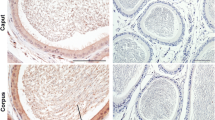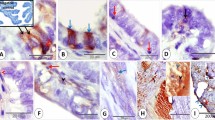Abstract
Introduction and hypothesis
Urinary incontinence is prevalent in postmenopausal women and spayed dogs and is associated with decreased estrogen plasma concentrations. The objective of the study was to investigate the expression of estrogen receptors (ER) in the urethra of sexually intact, ovariectomized, and estrogen-substituted ovariectomized ewes.
Methods
Paraffin cross-sections from each urethral quarter were immunohistochemically analyzed. The reactivity of ER was semiquantitatively assessed employing an immunoreactive score (IRS).
Results
In contrast to ERβ, ERα was identified in all urethral compartments; the highest IRS was detected in the epithelium of the distal urethra. The immunoreactivity and distribution of ERα did not differ among groups. Highly significant differences in ERα concentrations were observed between consecutive urethral quarters in each group.
Conclusions
Neither ovariectomy nor ovariectomy and estrogen substitution seem to have a significant effect on overall urethral ERα concentration. The results demonstrate that the precise location of the investigated urethral part is crucial to the reliable evaluation or possible comparison of ERα concentrations.



Similar content being viewed by others
Abbreviations
- ANOVA:
-
Factorial analysis of variance
- CEE:
-
Conjugated equine estrogen
- ER:
-
Estrogen receptor
- ERT:
-
Estrogen replacement therapy
- IRS:
-
Immunoreactive score
- NOC:
-
Non-operated control
- OVE:
-
Estrogen-substituted ovariectomized
- OVX:
-
Ovariectomized
- UI:
-
Urinary incontinence
- U1/4:
-
Urethral quarter 1 (connecting with urinary bladder)
- U4/4:
-
Urethral quarter 4 (connecting with vaginal vestibule)
- WHI:
-
Women’s Health Initiative
References
Townsend MK, Curhan GC, Resnick NM, Grodstein F (2009) Postmenopausal hormone therapy and incident urinary incontinence in middle-aged women. Am J Obstet Gynecol 200:86.e1–86.e5
Nygaard IE, Heit M (2004) Stress urinary incontinence. Obstet Gynecol 104:607–620
Holt PE (1990) Urinary incontinence in dogs and cats. Vet Rec 127:347–350
Janssens LA, Peeters S (1997) Comparisons between stress incontinence in women and sphincter mechanism incompetence in the female dog. Vet Rec 141:620–625
Reichler IM, Pfeiffer E, Piché CA, Jöchle W, Roos M, Hubler M, Arnold S (2004) Changes in plasma gonadotropin concentrations and urethral closure pressure in the bitch during the 12 months following ovariectomy. Theriogenology 62:1391–1402
Rymer J, Morris EP (2000) Extracts from “clinical evidence”: menopausal symptoms. BMJ 321:1516–1519
Hilton P, Stanton SL (1983) Urethral pressure measurement by microtransducer. The results in symptom-free women and in those with stress urinary incontinence. Br J Obstet Gynaecol 90:919–933
Walters MR, Nemere I (2004) Receptors for steroid hormones: membrane-associated and nuclear forms. Cell Mol Life Sci 61:2309–2321
Tincello DG, Taylor AH, Spurling SM, Bell SC (2009) Receptor isoforms that mediate estrogen and progestagen action in the female lower urinary tract. J Urol 181:1474–1482
Blakeman PJ, Hilton P, Bulmer JN (2000) Oestrogen and progesterone receptor expression in the female lower urinary tract, with reference to estrogen status. BJU Int 86:32–38
Iosif CS, Batra S, Ek A (1981) Estrogen receptors in the human female lower urinary tract. Am J Obstet Gynecol 141:817–820
Schulze H, Barrack ER (1987) Immunocytochemical localization of estrogen receptors in normal male and female canine urinary tract and prostate. Endocrinology 121:1773–1783
Savolainen S, Santti R, Streng T, Gustafsson JA, Härkönen P, Mäkelä S (2005) Sex specific expression of progesterone receptor in mouse lower urinary tract. Mol Cell Endocrinol 230:17–21
Rosenzweig BA, Bolina PS, Birch L, Moran C, Marcovici I, Prins GS (1995) Location and concentration of estrogen, progesterone, and androgen receptors in the bladder and urethra of the rabbit. Neurourol Urodyn 14:87–96
Batra SC, Iosif CS (1983) Female urethra: a target for estrogen action. J Urol 129:418–420
Augsburger HR, Cruz-Orive LM (1995) Stereological analysis of the urethra in sexually intact and spayed female dogs. Acta Anat 154:135–142
Augsburger HR, Oswald M (2007) Immunohistochemical analysis of collagen types I, III, IV and α-actin in the urethra of sexually intact and ovariectomized beagles. Int Urogynecol J 18:1071–1075
Seidlova-Wuttke D, Schultens A, Wuttke W (2004) Urodynamic effects of estradiol (E2) in ovariectomized (ovx) rats. Endocrine 23:25–32
Turner AS (2002) The sheep as a model for osteoporosis in humans. Vet J 163:232–239
Adams E, Turner AS, Wark JD (1995) The potential of sheep for the study of osteopenia: current status and comparison with other animal models. Bone 16:277S–284S
Webb R, Baxter G, MacBride D, Nordblum GD, Shaw MP (1985) The measurement of testosterone and oestradiol-17ß using iodinated tracers and incorporating an affinity chromatography extraction procedure. J Steroid Biochem 23:1043–1051
Schäubli M, Ritter N, Hässig M, Zerbe H, Bleul U, Boos A (2008) Progesterone receptors, oestrogen receptor α and glucocorticoid receptors in the bovine intercaruncular uterine wall around parturition. Anim Reprod Sci 103:215–227
Callahan SM, Creed KE (1985) The effects of oestrogens on spontaneous activity and responses to phenylephrine of the mammalian urethra. J Physiol 358:35–46
Quinn SD, Domoney C (2009) The effects of hormones on urinary incontinence in postmenopausal women. Climacteric 12:106–113
Reichler IM, Hubler M, Jöchle W, Trigg TE, Piché CA, Arnold S (2003) The effect of GnRH analogs on urinary incontinence after ablation of the ovaries in dogs. Theriogenology 60:1207–1216
Robinson D, Cardozo LD (2003) The role of estrogens in female urinary tract dysfunction. Urology 62(Suppl 4A):45–51
Hextal A (2000) Estrogen and lower urinary tract function. Maturitas 36:83–92
Hendrix SL, Cochrane BB, Nygaard IE, Handa VL, Barnabei VM, Iglesia C, Aragaki A, Naughton MJ, Wallace RB, McNeeley SG (2005) Effects of estrogen with and without progestin on urinary incontinence. JAMA 293:935–948
DuBeau CE (2005) Estrogen treatment for urinary incontinence. Never, now, or in future? JAMA 293:998–1001
Newman E, Turner AS, Wark JD (1995) The potential of sheep for the study of osteopenia: current status and comparison with other animal models. Bone 16:277S–284S
Acknowledgements
The authors thank Prof. Martin Cake (College of Veterinary Medicine, Murdoc University, Perth, Australia) for the collection and processing of blood samples and materials.
Conflicts of interest
None.
Author information
Authors and Affiliations
Corresponding author
Additional information
Brief summary
Ovariectomy and estrogen substitution do not seem to have an immunohistochemically ascertainable effect on urethral estrogen receptor concentration in the sheep
Rights and permissions
About this article
Cite this article
Augsburger, H.R., Führer, C. Immunohistochemical analysis of estrogen receptors in the urethra of sexually intact, ovariectomized, and estrogen-substituted ovariectomized sheep. Int Urogynecol J 25, 657–662 (2014). https://doi.org/10.1007/s00192-013-2275-8
Received:
Accepted:
Published:
Issue Date:
DOI: https://doi.org/10.1007/s00192-013-2275-8




